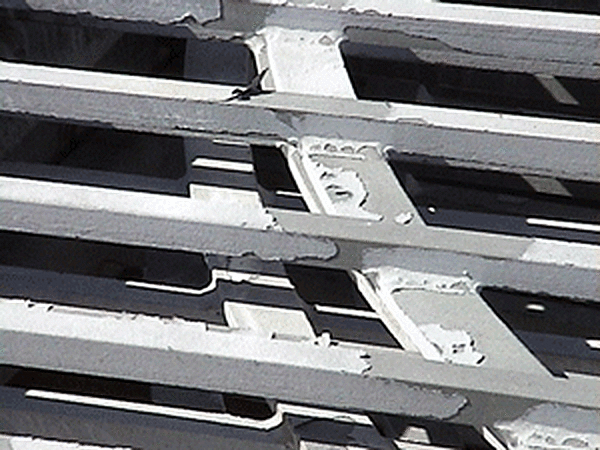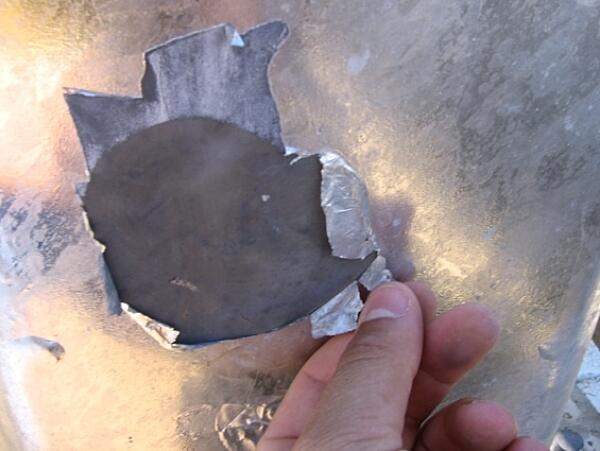Sweep Blasting Galvanized Steel
Can sweep blasting galvanized steel cause the galvanized coating to peel?

Peeling of a galvanized coating has several possible causes. Peeling can be caused by exposing galvanized steel to excessive temperatures (above 390F) for prolonged periods of time, which can mean just a few minutes or a few hours of exposure, depending on the temperature. Peeling can also occur when the steel cools very slowly after it has been galvanized. When peeling is due to long cool times, it usually happens on thick steel (1 inch or greater in thickness), on pipe and tubing, or on steel that was stacked while still hot. Lastly, peeling of the galvanized coating can occur when the galvanized coating has been overblasted. Before we discuss peeling of the galvanized coating due to overblasting, it is important to understand what peeling is. Peeling occurs when the free zinc layer (the outer layer also known as the eta layer) separates from the intermetallic layers of the galvanized coating. The other coating defect that happens when the galvanized coating comes off the steel is known as flaking, which is when nearly the entire galvanized coating comes off the steel (free zinc and intermetallic layers).

A simple test to verify whether you are dealing with peeling is to take a coating thickness measurement in the affected area. If there is a coating thickness of approximately one mil or more on the steel, the defect is peeling of the galvanized coating. If a coating thickness measurement shows a near-zero reading, the issue is flaking. Visually, peeling can be diagnosed by looking for thin sections of zinc coming off the steel that look almost like tin foil (see Figure 1). Peeling can also appear as blisters on the galvanized coating. Flaking of the coating usually happens in bigger and stiffer chunks with much more defined edges. Sweep blasting the galvanized coating is a common step done during preparation for painting galvanized steel. Sweep blasting increases the profile of the galvanized coating and thereby allows for increased adhesion of the paint to the coating. Sweep blasting is preferred over standard blasting because standard blasting could remove most of the coating, whereas sweep blasting, when done correctly, removes only zinc corrosion compounds and not the zinc metal layer (eta layer). Several factors are important to keep in mind when sweep blasting galvanized steel, including choice of abrasive material, angle of blast, blast pressure, and temperature of the steel. Some materials that have been successfully used to sweep blast galvanized steel include aluminum/magnesium silicate, soft mineral sands with a Mohs hardness rating of five or less, organic media such as corn cobs or walnut shells, or stone materials such as corundum and limestone.

- Particle size for abrasives should be between 200 and 500 micrometers.
- Blast angle should be between 30 and 60 degrees relative to the steel surface.
- Blast pressure should be 40 psi or less.
- Finally, the substrate should be maintained at least three degrees centigrade above the dew point.
When abrasive materials harder than those mentioned above are used, or when the recommended blast pressure or angle is exceeded, peeling of the galvanized coating can occur. Overblasting is not always intentional, as seen in Figure 2. On this project one side of a concrete wall with attached galvanized angles was blasted to achieve a desired finish. The blaster was unaware that using a blast pressure and media necessary for concrete would damage the galvanized coating on the attached galvanized angles. The result was a galvanized coating that began blistering and peeling. Overblasting of the galvanized coating is easily preventable when the blaster is aware of the necessary requirements for sweep blasting galvanized steel. This information can be found in the AGA publication, Preparing Hot-Dip Galvanized Steel for Paint, which is available as a download or for a small fee in print edition, which includes an instruction video on DVD.
Occasionally, the AGA is asked about the use of steel shot and grit. These abrasives have been successfully used to prepare galvanized surfaces. Generally the use of grit will provide a surface with sharp angularity and peak counts more suitable for industrial coatings than can be achieved using shot. However, experience says there is often the potential for embedment of abrasive media in the surface layer of the zinc. For galvanized surfaces prepared with iron-containing abrasives such as steel grit, performance of the paint or powder coating system may be influenced by embedment of the abrasive and the chance for bi-metallic corrosion.
© 2025 American Galvanizers Association. The material provided herein has been developed to provide accurate and authoritative information about after-fabrication hot-dip galvanized steel. This material provides general information only and is not intended as a substitute for competent professional examination and verification as to suitability and applicability. The information provided herein is not intended as a representation or warranty on the part of the AGA. Anyone making use of this information assumes all liability arising from such use.

